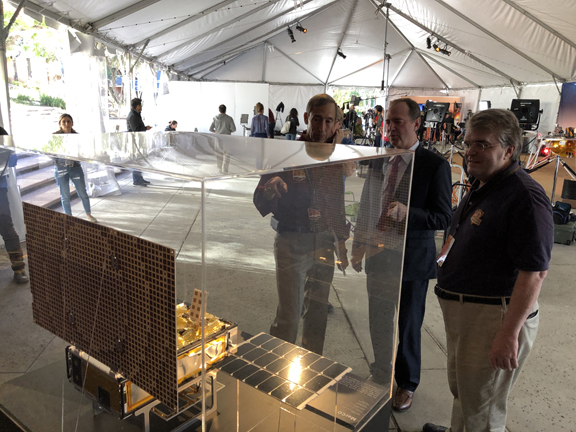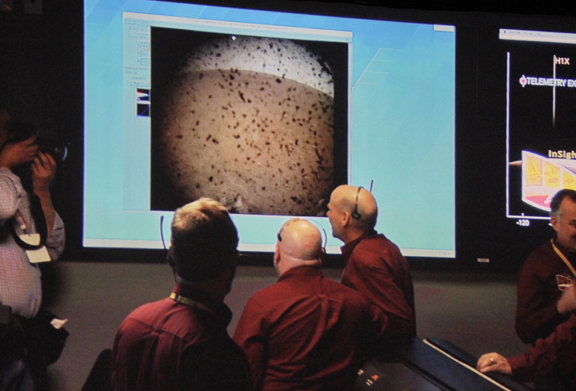
Larry James leads a tour, stopping at the MarCO cube, with Representatives Adam Schiff and John Culberson.
By Charly SHELTON
InSight is the newest lander to touch down on the Martian surface after a successful EDL (Entry-Descent-Landing) event on Monday. InSight is only the eighth mission to successfully reach the surface of the planet out of 19 total attempts by humans to get a rover or lander to the Red Planet. Getting from the surface of Earth to the surface of Mars is no small task, which started with choosing where to land. Dr. Matt Golombek, Science Team member on InSight, geology and landing site lead, was the one who made that determination.
“For any site selection, the first things you look at are the engineering requirements that are needed by the mission,” Dr. Golombek said. “So for Mars, latitude and elevation are the two most important things right up front. This mission is lasting for a full Mars year and it’s solar powered, so it needs to be near the equator to get an even and adequate amount of sunlight to power the spacecraft. Elevation is important because you use the atmosphere to slow you down to land, and we needed to be at a particular elevation [to have enough atmosphere to do the job]. Between the latitude and the elevation, there were only four small areas on Mars to select and three of them were either too small to put an ellipse [projected landing area] that was 130 kilometers by 27 kilometers on a smooth, flat plane, or it was too rocky. So this was the only place to go.”

After four years of searching through hi-res images from the Mars Reconnaissance Orbiter, Dr. Golombek and his team settled on Elysium Planitia, near the equator of Mars about 4.5 degrees north latitude and 135.9 degrees east longitude. To put that in context, it is about 340 miles from where Curiosity is now, 1,600 miles from Spirit and 5,200 miles from Opportunity.
InSight, a mission to study the interior of Mars through seismology and heat measurements, is a product of another mission’s instrument failure back in 1975 – the Viking landers, which carried a seismometer that malfunctioned and couldn’t take readings. This has been something Dr. Bruce Bannerdt, InSight’s principal investigator, has wanted to rectify ever since. With today’s technology and a mission dedicated to geological and seismological readings, the findings of InSight can show scientists much more than just ground motion. InSight will be looking at the ancient history of rocky planets like Earth.

“The overall goal of all three instruments [that are onboard InSight] is to understand the interior structure of the planet. Mars is kind of the Goldilocks planet because it’s big enough that it tells how the planet differentiated – how did the core fall to the bottom and the mantle form [in the middle] and the crust on top. [Much of the evidence of this process is] destroyed on the Earth; it’s too active. So this will give us a very good idea about how all terrestrial planets initially formed and differentiated in the very early days as a key to how they’ve evolved since.”
The three instruments onboard the lander are the seismometer – a Marsquake measuring device that can sense motion in the crust as small as the radius of a single atom, the Heat Flow and Physical Properties Probe, which will bore down 10 to 16 feet below the surface to take temperature readings of the core of the planet, and the Rotation and Interior Structure Experiment, which will use InSight’s radio signal to track its motion as the planet spins to measure the wobble in the planet’s rotation axis, belying a moving, molten core and providing details as to its size.

InSight started sending pictures the first moment it landed on Mars and will continue to send pictures home throughout the two-Earth-years length of its prime mission.
For more information and to see pictures, visit Mars.NASA.gov/InSight.
